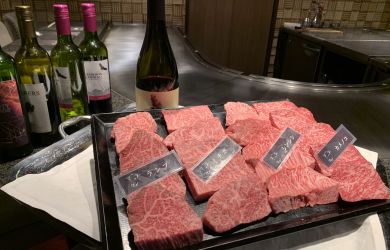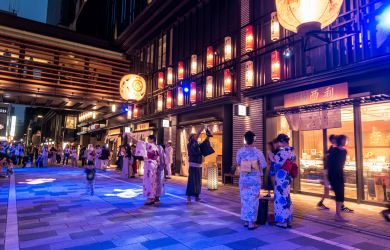
October 24, 2008
Sugamo
The obachan version of Takeshita Dori awaits in northern Tokyo
By Metropolis
Originally published on metropolis.co.jp on October 2008

Photos By Alena Eckelmann
Most Tokyo residents know of Sugamo as a ne’er-visited stop on the Yamanote line—if they know of it at all. Yet here lies one of the city’s most interesting shopping streets. Think Center Gai or Takeshita Dori—for your grandma. The average visitor to Sugamo’s Jizo Dori is silver-haired but with a sparkle in the eye. Hordes of Japan’s Greatest Generation flock to the district that postwar modernization forgot.
Almost 1km in length, the Jizo Dori arcade has over 200 shops specializing in all manner of goods for the silver generation. You’ll find comfy shoes and clothes in droves, many at Takeshita-like bargain prices. Some stalls sell the latest and greatest hearing aids, while others hawk designer walking canes. Japan’s love of brand-name fashion evidently knows no age.
As one might suspect, health-related products feature high on the shopping lists of the elderly; on Jizo Dori, you’ll find no fewer than eight drugstores, two pharmacies and three kampo apothecaries. Don’t let the bizarre potions displayed in the windows put you off. These traditional Chinese recipes have undergone a few thousand more years of R&D than those painkillers in your purse. Those with a sweet tooth might try the herbal ice cream.

Photo by Alena Eckelmann
Sugamo is a clearinghouse of all things traditional—first and foremost, food. One shop after another offers Japanese confectionaries, rice crackers, green tea and cooking ingredients. Samples of traditional sweets and savories abound. First-time visitors are behooved to try shio-daifuku—rice balls with sweet red been paste and a sprinkle of salt. These are Sugamo’s answer to the crepes of Harajuku.
But even more than the foodstuffs, Sugamo is best-known for is red-hot granny panties. Aka-pantsu are said not only to improve the wearer’s health and vigor, but also ward off evil spirits and bring happiness. Not bad for a pair of drawers.
So what’s the reasoning? Well, for starters the color red is considered auspicious. The Japanese also believe that the center of a person’s well-being is located in the lower back/belly region. So keep your midsection warm and protected, and be rewarded with strength and happiness—or so they say. To pick up a pair of aka-pantsu, swing by any of the area’s several outlets of Maruji. Also on offer are red boxer shorts, long johns, body warmers and socks. Some items even sport a Sugamo logo or zodiac sign.

Photo by Alena Eckelmann
Any visit to the neighborhood should include a stop at Koganji temple, which lies just off Jizo Dori. Devotees to the Goddess of Mercy line up to for the opportunity to wash the region of the statue that corresponds to their ailing body part. This is done with a white towel that can be purchased there and, after scrubbing the statue, can be taken home and placed on the affected area. It is believed that doing so will cause your body to heal. Koganji always has long lines of people waiting and chatting about their health problems. If looking for empathy for your back pain, there’s no better place to find it.
The temple is also home to the Togenuki Jizo, the namesake of the nearby street. In addition to its ability to alleviate pain, the bodhisattva is the guardian deity of children. The popularity of the statue is such that many local food shops sell Jizo-themed soba, sweets, tea and the like.
Jizo Dori itself has an interesting history. During the Edo era, the road was part of the storied Nakasendo highway. A stone at the end of the street, easily overlooked, is a reminder of Sugamo being an outpost on the route between Edo and Kyoto.
Another piece of history can be found in the Toden Arakawa line, a streetcar that runs along northern Tokyo and passes through Sugamo. Opened in 1913 and originally part of an extensive tramline network, the stretch connecting Waseda and Minowabashi is all that’s left after 95 years of operation.
So if you fancy a change from modern Tokyo, you can still experience the city of old in Sugamo—even if you still have a few years before you fit in.
Getting to Sugamo is easy—it’s on the Yamanote line. To get to Jizo Dori, turn right out of the station, cross the street and walk along the roofed shopping arcade for five minutes. You can also arrive (or depart) via the Toei Mita subway line’s Sugamo station (exit A3), or on the Toden Arakawa streetcar via Sugamo-Shinden station. The best time to visit is on a date ending in 4 (i.e., the 4th, 14th and 24th), when Jizo Dori bustles with even more stalls and a flea market takes place at the end of the street. To get your hands on aka-pantsu, try Maruji on Jizo Dori (4-21-11 Sugamo, Toshima-ku; tel: 03-3910-1409).
For Japanese fabric and crafts check out Fuyusha (3-20-14 Sugamo, Toshima-ku; tel: 03-3915-0377). For additional information in Japanese, see the website for the Sugamo Jizo Dori Shopping Center Promotion Association (www.sugamo.or.jp).





